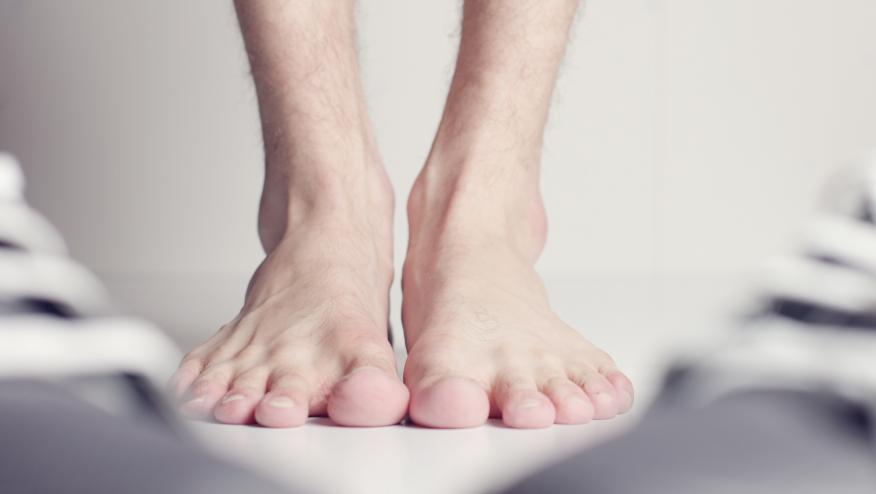Foot Pain Commonly Overlooked in RA Save

Foot pain is a common but underappreciated symptom of rheumatoid arthritis (RA) and can be associated with worse disease, European researchers found.
In a cohort of 320 patients with RA, 69% reported foot or ankle pain, according to Morten Bilde Simonsen, PhD, of Aalborg University in Denmark, and colleagues.
And fewer of those who reported foot or ankle pain were in remission compared with those without the pain (48.9% vs 75%, P<0.001), the researchers reported online in ACR Open Rheumatology.
Among patients with RA, foot and ankle synovitis "may lead to tenderness, swelling, pain, stiffness, joint destruction, and altered foot mechanics, which increase the risk of falls and impair quality of life," the team observed. Yet the foot joints are not included in the commonly used Disease Activity Score in 28 joints (DAS28), which focuses on the hand, wrist, elbow, shoulder, and hips. Therefore, relying solely on the DAS28 for treatment decisions could result in eventual irreversible foot deformities, so additional tools are needed to assess pain and other problems in the feet and ankles, Simonsen and co-authors noted.
One such tool is the Self-reported Foot and Ankle Score (SEFAS), which was initially developed for patients undergoing foot or ankle surgery, while a 12-joint foot count can help quantify swollen and tender ankle and metatarsophalangeal joints.
To examine the prevalence of foot and ankle pain and its association with disease severity and function, the investigators conducted a survey of patients seen at the Danish Hospital for Rheumatic Diseases from September to December 2019. Participants were asked if they were experiencing any pain in the feet or ankles at present, if the problem preceded the diagnosis of RA, and if the pain was unilateral or bilateral.
The mean age of participants was 64, and median disease duration was 11.5 years. Almost three-quarters were women. Foot pain was present in 220 patients and absent in 100.
Among those who reported foot or ankle pain, the problem was bilateral in 71% and did not commonly precede the RA diagnosis. Compared with those not reporting pain, patients with pain were younger (62.5 vs 66.3 years, P=0.016). They were less likely to be receiving treatment with conventional disease-modifying antirheumatic drugs (DMARDs) (57.2% vs 66%, P<0.001), but more often were using biologics (42.8% vs 38%, P<0.001).
Patients reporting pain also scored worse on multiple measures of disease:
- Health Assessment Questionnaire (HAQ), 0.9 vs 0.4 (P<0.001)
- Global health, 42 vs 22 (P<0.001)
- Overall pain, 36.4 vs 21.1 (P<0.001)
- Fatigue, 47.5 vs 26.6 (P<0.001)
- DAS28, 2.7 vs 2 (P<0.001)
- Swollen 28-joint count, 0.8 vs 0.2 (P=0.015)
- Swollen 12-joint foot/ankle count, 0.2 vs 0 (P=0.004)
- Tender 12-joint foot/ankle count, 1.7 vs 0.2 (P<0.001)
Mean SEFAS among the pain group was 26.95. Physical function variables associated with the SEFAS included worse HAQ (β = -3.634, 95% CI -5.681 to -1.587, P=0.002), difficulties walking 3 km (β = -2.733, 95% CI -3.963 to -1.503, P<0.001), and problems with participating in recreational activities (β = -1.290, 95% CI -2.438 to -0.142, P=0.028).
There also was a borderline negative association between worse SEFAS and tender 12-joint counts (β = -0.345, 95% CI -0.707 to 0.017).
The authors noted that simply adding the 12-joint foot/ankle count would not sufficiently reflect patients' foot problems, because the pain may originate from structures other than the joints, such as tendons and muscles. "The assessment of foot problems and foot biomechanics is a key issue in unmet needs that requires research by the European League Against Rheumatism research roadmap," the investigators stated.
The SEFAS did appear to be useful in this study, with scores similar to what has been reported for patients undergoing surgery for hallux valgus deformities and showing associations with routine activities.
A limitation of the study, the team noted, was the fact that the data were collected in the autumn, at a time when disease activity has been reported to be lower than in the winter and spring, so the prevalence of pain may have been underestimated.
The observation that even patients in remission experience foot and ankle pain -- almost half in this cohort -- "does not necessarily mean poor inflammatory control, as residual pain often persists because of joint damage and may also be part of a more widespread pain problem," Simonsen and co-authors wrote. Using the SEFAS or even asking a single question about pain in the foot or ankle "will contribute ... additional information on foot problems not identified by joint examinations and may facilitate a patient-physician discussion."
Source Reference: Simonsen M, et al "Foot and ankle problems in patients with rheumatoid arthritis in 2019: Still an important issue" ACR Open Rheum 2021; DOI: 10.1i002/acr2.11258.










If you are a health practitioner, you may Login/Register to comment.
Due to the nature of these comment forums, only health practitioners are allowed to comment at this time.